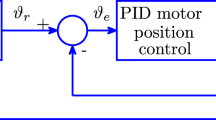Abstract
In the present paper, the delayed feedback control is applied to suppress or stabilize the vibration of the primary system in a two degree-of-freedom dynamical system with parametrically excited pendulum. The case of a 1:2 internal resonance between pendulum and primary system is studied. The method of multiple scales is applied to obtain second-order approximations of the response of the system. The system stability and bifurcations of equilibrium point of the averaged equations are computed. It is shown that the delayed feedback control can be used to suppress the vibration or stabilize the system when the saturation control is invalid. The vibration of the primary system can be suppressed by the delayed feedback control when the original system is in the single-mode motion. The effect of gain and delay on the vibration suppression is discussed. As the delay varies at a fixed value of the gain, the vibration of the primary system can be suppressed at some values of the delay. The vibration suppression performance of the system is improved at a large value of the gain. The vibration of the primary system could be suppressed about 56% compared with the original system by choosing the appropriate values of gain and delay. The delayed feedback control also can be used to stabilize the system when the original system is unstable. The gain and delay could be chosen as the controlling parameters. Numerical simulation is agreement with the analytical solutions well.
Similar content being viewed by others
References
Nayfeh, A., Mook, D., Marshall, L.: Nonlinear coupling of pitch and roll modes in ship motion. J. Hydronaut. 7(4), 145–152 (1973)
Haddow, A., Barr, A., Mook, D.: Theoretical and experimental study of modal interaction in a two-degree-of-freedom structure. J. Sound Vib. 97(3), 451–473 (1984)
Oueini, S., Golnaraghi, M.F.: Experimental implementation of the internal resonance control strategy. J. Sound Vib. 191(3), 377–396 (1996)
Oueini, S., Nayfeh, A.: Analysis and application of a nonlinear vibration absorber. J. Vib. Control 6(7), 999–1016 (2000)
Pai, P., Wen, B., Naser, A., Schultz, M.: Structural vibration control using PZT patches and non-linear phenomena. J. Sound Vib. 215, 273–296 (1998)
Pratt, J., Oueini, S., Nayfeh, A.: A Terfenol-D nonlinear vibration absorber. J. Intell. Mater. Syst. Struct. 10, 29–35 (1999)
Li, J., Hua, H.X., Shen, R.Y.: Saturation-based active absorber for a non-linear plant to a principal external excitation. Mech. Syst. Signal Process. 21, 1489–1498 (2007)
Haxton, R., Barr, A.: The autoparametric vibration absorber. J. Eng. Ind. 94, 119–125 (1972)
Banerjee, B., Bajaj, A.K., Davies, P.: Resonant dynamics of an autoparametric system: A study using higher order averaging. Int. J. Non-Linear Mech. 31, 21–39 (1993)
Bajaj, A.K., Chang, S.I., Johnson, J.M.: Amplitude modulated dynamics of a resonantly excited autoparametric two degree-of-freedom system. Nonlinear Dyn. 5, 433–457 (1994)
Song, Y., Sato, H., Iwata, Y., Komatsuzaki, T.: The response of a dynamic vibration absorber system with a parametrically excited pendulum. J. Sound Vib. 259(4), 747–759 (2003)
Zhao, Y.Y., Xu, J.: Effects of delayed feedback control on nonlinear vibration absorber system. J. Sound Vib. 308, 212–230 (2007)
Olgac, N., Holm-Hansen, B.T.: A novel active vibration absorption technique: delayed resonator. J. Sound Vib. 176(1), 93–104 (1996)
Olgac, N., Jalili, N.: Modal analysis of flexible beams with delayed resonator vibration absorber: theory and experiments. J. Sound Vib. 218(2), 307–331 (1998)
Olgac, N., Hosek, M.: A new perspective and analysis for regenerative machine tool chatter. Int. J. Mach. Tools Manuf. 38, 783–798 (1998)
Jalili, N., Olgac, N.: Multiple delayed resonator vibration absorbers for mul-degree-of-freedom mechanical structures. J. Sound Vib. 223(4), 567–585 (1999)
Filipovic, D., Olgac, N.: Delayed resonator with speed feedback-design and performance analysis. Mechatronics 12, 393–413 (2002)
Olgac, N., Sipahi, R.: An exact method for the stability analysis of time-delayed linear time-invariant (LTI) system. IEEE Trans. Autom. Control 47(5), 793–797 (2002)
Zhao, Y.Y., Xu, J.: Effects of delayed feedback control on vibration suppression in an autoparametric dynamical absorber. Acta Mech. Solida Sin. 28(4), 347–354 (2007)
Zhao, Y.Y., Xu, J.: Mechanism analysis of delayed nonlinear vibration absorber. Acta Mech. Sin. 40(1), 98–106 (2008)
Wirkus, S., Rand, R.: The dynamics of two coupled van der Pol oscillators with delay coupling. Nonlinear Dyn. 30, 205–221 (2002)
Author information
Authors and Affiliations
Corresponding author
Rights and permissions
About this article
Cite this article
Zhao, Y.Y., Xu, J. Using the delayed feedback control and saturation control to suppress the vibration of the dynamical system. Nonlinear Dyn 67, 735–753 (2012). https://doi.org/10.1007/s11071-011-0023-5
Received:
Accepted:
Published:
Issue Date:
DOI: https://doi.org/10.1007/s11071-011-0023-5




